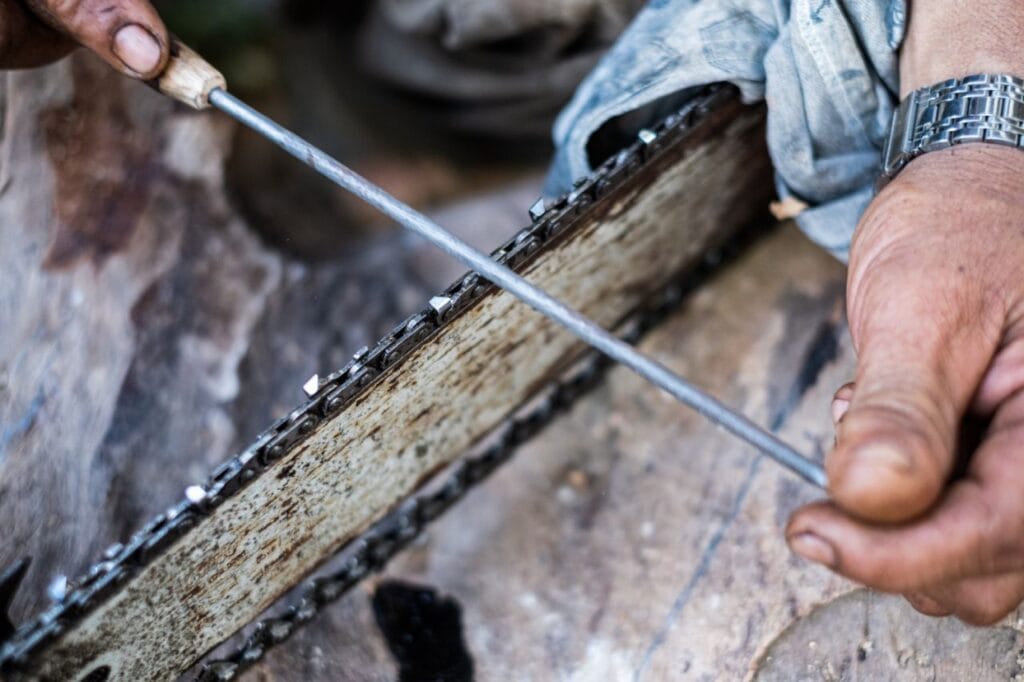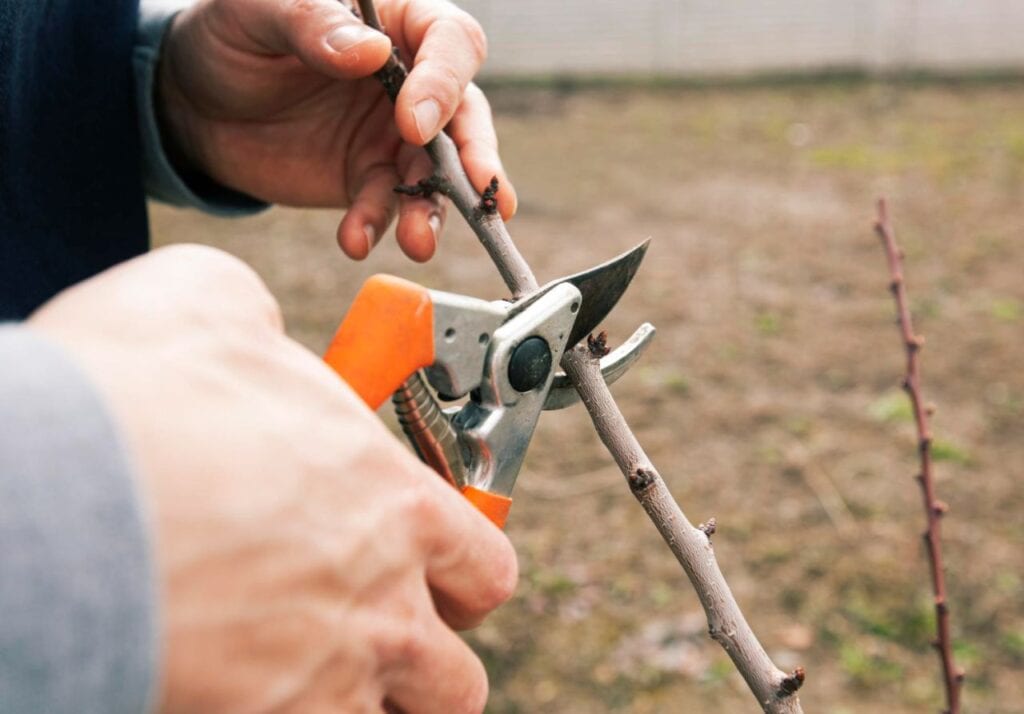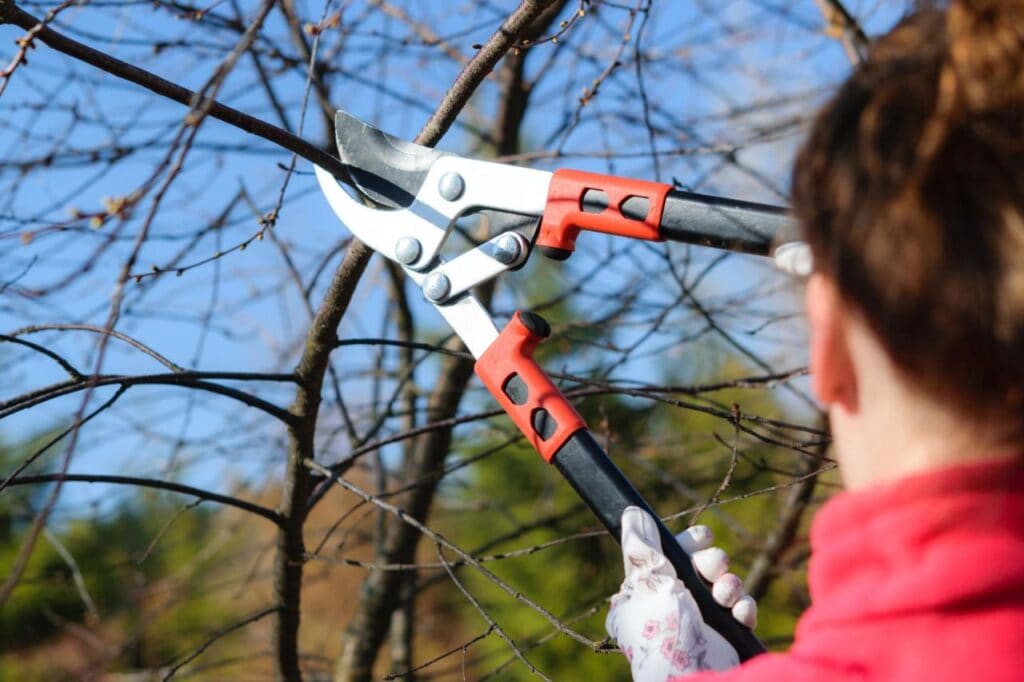Regular pruning of plants by removing dead, diseased and damaged growth keeps them vigorous and healthy.
Thinning the canopy lets light in and improves air circulation, reducing the incidence of pests and disease – without the need for sprays.
For more vigorous plants such as wisteria and buddleja, pruning can encourage prolific flowering and cropping, while cutting in the right place can train them into the desired shape for a controlled and tidy finish.
Most pruning is done in winter, but this isn’t universal, so check the pruning requirements of your plant before you make any cuts.
Improve your skills with these tips for better pruning.
- Crown thinning: It is the removal of a portion of smaller branches (usually at the outer crown) to produce a uniform density of foliage around an evenly spaced branch structure, and it does not change the overall shape or size of a tree.
- Keep lateral branches as evenly spaced as possible, and especially on younger trees.
- Never remove more than one-fourth of a living crown at once. If you have to remove more than that, you should spread it out for a few years.
- Crown raising: It can be done to provide some clearance for pedestrians or cars pulling into driveways. The crown of a tree can be raised if pruning is done carefully. You’ll want to maintain live branches on two-thirds of the tree’s height. If too many branches are removed on the lower half, it may prevent the tree from developing a strong stem.
- Crown reduction: Crown reduction is different from crown thinning in that it reduces the canopy size of the tree, but it is not a good idea to get a crown reduction if at all possible. It is an extensive and severe form of pruning that is used for reducing the weight of possibly dangerous limbs, balancing an uneven tree, and preventing trees from obstructing or damaging power lines or buildings.
- If you have to remove more than half of the foliage from a branch, it’s best to remove the whole limb.
- Prune lateral branches that are at least one-third of the diameter of the stem that needs to be removed.
Pruning is an essential gardening skill.
When you prune correctly, you encourage healthy growth and flowering (in the case of flowering plants), as well as good looks. For most shrubs and trees, it helps to prune at the right time. Some are best pruned in winter, some right after flowering. Check this list of affordable Perth Arborist to help you decide which services to choose.
Tips For Better Pruning
Proper pruning enhances the beauty of almost any landscape tree and shrub, while improper pruning can ruin or greatly reduce its landscape potential.
In most cases, it is better not to prune than to do it incorrectly. In nature, plants go years with little or no pruning, but man can ruin what nature has created.
By using improper pruning methods, healthy plants are often weakened or deformed. In nature, every plant eventually is pruned in some manner.
It may be a simple matter of low branches being shaded by higher ones resulting in the formation of a collar around the branch's base, restricting the flow of moisture and nutrients.
Eventually, the leaves wither and die, and the branch then drops off in a high wind or storm.
Often, tender new branches of small plants are broken off by wild animals in their quest for food.
In the long run, a plant growing naturally assumes the shape that allows it to make the best use of light in a given location and climate.
All one needs to do to appreciate a plant’s ability to adapt to a location is to walk into a wilderness and see the beauty of natural growing plants.
Pruning, like any other skill, requires knowing what you are doing to achieve success.
The old idea that anyone with a chainsaw or a pruning saw can be a landscape pruner is far from the truth. More trees are killed or ruined each year from improper pruning than by pests.
Remember that pruning is the removal or reduction of certain plant parts that are not required, that are no longer effective, or that are of no use to the plant. It is done to supply additional energy to develop flowers, fruits, and limbs that remain on the plant.
Pruning, which has several definitions, essentially involves removing plant parts to improve the health, landscape effect, or value of the plant. Once the objectives are determined, and a few basic principles understood, pruning primarily is a matter of common sense.
The necessity for pruning can be reduced or eliminated by selecting the proper plant for the location. Plants that might grow too large for the site, are not entirely hardy, or become unsightly with age should be used wisely and kept to a minimum in the landscape plan.
Advances in plant breeding and selection in the nursery industry provide many plants requiring little or no pruning. However, even the most suitable landscape plants often require some pruning. The guidelines presented in this publication should be helpful when pruning any plant.
Reasons for Pruning
- to train the plant
- to maintain plant health
- to improve the quality of flowers, fruit, foliage or stems
- to restrict growth
Definitions of Terms
- Broad-leaved evergreen —an evergreen plant with broad leaves that are not needle-shaped.
- Calliper —refers to the diameter of a tree. In nursery-landscape practice, callipers are measured 6 inches above the ground level up to and including 4-inch diameter size and 12 inches above the ground level for larger sizes.
- Candle —refers to early spring growth of pine shoots before needle expansion.
- Central leader —the main stem of the tree from which other branches develop. In most cases, it is the trunk.
- Crotch —the angle developed between two connecting branches.
- Deciduous —plants that normally have left only during the growing season and lose their leaves during the dormant season.
- Dieback —the dying back of stems due to adverse weather conditions, insects, diseases or other causes.
- Dormant —the year when a plant is not growing.
- Espalier —to train a plant on a wire or trellis against a wall or other support.
- Lateral —a branch originating from the main trunk.
- Multiple stemmed plants —plants with more than one stem from the base compared to plants with only a central leader.
- Narrow-leaved evergreen —an evergreen plant with needle-shaped leaves.
- Permanent branch —a branch that is part of the major growth habit of the tree, usually originating from the trunk.
- Radial branch spacing —the distribution of branches around the trunk of a tree.
- Scaffold branching —a permanent branch originating from the trunk and becoming a part of the major branching or framework of the tree.
- Shearing —cutting back plants with hedge shears resulting in a very formal growth habit. Limit sharing to hedges, topiary or where a formal garden is to be maintained.
- Sucker —a vigorous shoot originating from root or stem tissue below ground.
- Temporary branch —a branch usually originating from the trunk removed by pruning after permanent branches have been selected.
- Terminal —tip ends of branches.
- It is thinning —removing connecting branches to the point of origin or shortening the length of a branch by cutting to a lateral.
- Training —to dictate the development and growth of a plant by physical means, such as pruning.
- Vertical branch spacing —distribution of branches up and down the trunk of a tree.
- Water spout —vigorous shoots are arising from the trunk or older branches.
- Wound —an area where the bark of a plant is cut or damaged.
- Wound dressing — a specially formulated material often called pruning paint, which is applied to tree wounds.
Plan Approach to Pruning
Pruning should follow a definite plan. Consider the reason or purpose before cutting begins.
By making the pruning cuts in a certain order, the total number of cuts is reduced greatly.
The skilled pruner first removes all dead, broken, diseased or problem limbs by cutting them at the point of origin or back to a strong lateral branch or shoot. Often, removing this material opens the canopy sufficiently so that no further pruning is necessary.
The next step in pruning is to make any training cuts needed.
By cutting back lateral branches, the tree or shrub is trained to develop the desired shape, to fill in an open area caused by storm or wind damage, or to keep it in bounds to fit a given area. To properly train a plant, one should understand its natural growth habit.

Always avoid destroying the natural shape or growth habit when pruning unless maintaining a close watch over the plant, for after some time, it attempts to assume the more natural growth habit.
Make additional corrective prunings to eliminate weak or narrow crotches and remove the less desirable central leader where double leaders occur.
After these cuts have been made, stand back and take a look at your work. Are there any other corrective pruning cuts necessary? If the amount of wood removed is considerable, further pruning may need to be delayed a year.
Remove water sprouts unless needed to fill a hole or shade a large limb until other branches develop.
When to Prune
Pruning can be done at any time of the year; however, recommended times vary with different plants.
Contrary to popular belief, pruning at the wrong time of the year does not kill plants, but continual improper pruning results in damaged or weakened plants. Do not prune at the convenience of the pruner, but rather when it results in the least damage to the plant.
There is little chance of damaging the plant if this rule is followed. In general, the best time to prune most plants is during late winter or early spring before growth begins.
There are exceptions to this rule, and they will be noted under the discussion of the specific plant groups.
The least desirable time is immediately after new growth develops in the spring.
A great amount of food stored in roots and stems is used in developing new growth. This food should be replaced by new foliage before it is removed; if not, considerable dwarfing of the plant may occur. This is a common problem encountered in pruning.
It also is advisable to limit the amount of pruning done late in summer as new growth may be encouraged on some plants.
This growth may not have sufficient time to harden off before cold weather arrives, resulting in cold damage or winter kill. Planning for a tree lopping, pruning, wood chipping, mulching, palm removing & stump grinding? At Tree Amigos, you can find high quality and affordable arborist services for your needs.
Prune plants damaged by storms or vandalism or ones with dead limbs as soon as possible to avoid additional insect and disease problems that may develop.
Making Pruning Cuts Correctly
To encourage rapid healing of wounds, make all cuts clean and smooth. This requires good, sharp pruning equipment. Do not leave stubs since they are usually where dieback occurs. Avoid tearing the bark when removing large branches. The following provides some specifics on pruning techniques.
Most woody plants fall into two categories based on the arrangement of the buds on the twigs and branches. In general, the bud arrangements determine the plants' typical growth habits.
Buds may have an alternate or an opposite arrangement on the twigs. A plant with alternate buds usually is rounded, pyramidal, inverted pyramidal, or columnar.
Plants having opposite buds rarely assume any form other than that of a rounded tree or shrub with a rounded crown. The position of the last pair of buds always determines the direction in which the new shoot will grow.
Buds on top of the twig probably will grow upward at an angle and to the side on which it is directed.
In most instances, it is advisable to cut back each stem to a bud or branch. Selected buds that point to the outside of the plant are more desirable than buds pointing to the inside.
By cutting to an outside bud, the new shoots will not grow through the interior of the plants or crisscross.
When cutting back to an intersecting (lateral) branch, choose a branch that forms an angle of no more than 45 degrees with the branch to be removed. Also, the branch you cut back to should have a diameter of at least half that of the branch to be removed.
Make slanting cuts when removing limbs that grow upward; this prevents water from collecting in the cut and expedites healing.
To “open” a woody plant, prune out some of the centre growth and cut back terminals to the buds that point outward. In shortening a branch or twig, cut it back to a side branch and cut 1/2 inch above the bud.
If the cut is too close to the bud, the bud usually dies. If the cut is too far from the bud, the wood above the bud usually dies, causing dead tips on the end of the branches.
When the pruning cut is made, the buds nearest to the cut usually produce the new growing point.
When a terminal is removed, the nearest side buds grow much more than they normally would, and the bud nearest the pruning cut becomes the new terminal. If more side branching is desired, remove the tips of all limbs.
The strength and vigour of the new shoot are often directly proportioned to the amount that the stem is pruned back since the roots are not reduced. For example, if the deciduous shrub is pruned to 1 foot from the ground, the new growth will be vigorous with few flowers in the first year.
However, if only the tips of the old growth are removed, most of the previous branches are still there, and new growth is shorter and less vigorous. Flowers will be more plentiful, although smaller.
Thus, if a larger number of small flowers and fruits are desired, prune lightly. If fewer but high-quality blooms or fruits are wanted in succeeding years, prune extensively.
Thick, Heavy Branches
Forest Service plant pathologist, thick and heavy branches should be removed flush to the collar at the branch's base, not flush with the trunk. The collar is an area of tissue containing a chemically protective zone.
In the natural decay of a dead branch, when the decay advancing downward meets the internal protected zone, very strong wood meets an area of very weak wood.
The branch then falls away at this point, leaving a small zone of decayed wood within the collar. The decay is walled off in the collar. This is the natural shedding process when all goes according to nature’s plan.
When the collar is removed, the protective zone is removed, causing a serious trunk wound. Wood-decay fungi can then easily infect the trunk. If the pruned branch is living, removing the collar at the base still causes injury.
When cutting branches more than 1 1/2 inches in diameter, use a three-part cut. The first step is to saw an undercut from the bottom of the branch about 6 to 12 inches out of the trunk and about one-third of the way through the branch. Make a second cut from the top, about 3 inches further from the undercut, until the branch falls away.

The resulting stub can then be cut back to the collar of the branch. If there is the danger of the branch damaging other limbs or objects on the ground, it should be properly roped and supported, then carefully lowered to the ground.
Topping Versus Thinning
All too often, trees are topped (“dehorned”) to reduce the size or rejuvenate growth. In either case, topping is not a recommended practice; in fact, some refer to it as the “chain saw massacre”.
Topping is the process whereby a tree is cut back to a few large branches. After 2 to 3 months, regrowth on a topped tree is vigorous, bushy and upright. Topping seriously affects the tree’s structure and appearance. This article will help you make a decision about tree stumping and removal. Here at Tree Amigo, we’re passionate about trees!
The weakly attached regrowth can break off during severe wind or rainstorms. Topping may also shorten the life of a tree by making it susceptible to attack by insects and disease.
Thinning is a better means of reducing the size of a tree or rejuvenating growth. In contrast to topping, thinning removes unwanted branches by cutting them back to their point of origin. Thinning conforms to the tree’s natural branching habit and results in a more open tree, emphasising the branches’ internal structure. Thinning also strengthens the tree by forcing the diameter growth of the remaining branches.
Frequently Asked Questions About Pruning
As a general rule, a light summer pruning can be performed on most deciduous trees and shrubs. Heavier pruning should be performed when the tree is dormant, preferably in late winter before active growth begins.
Pruning can remove any portions that have a disease, fungi, and other types of decay, stopping it from spreading to healthier branches. Removing these branches can also expose the others to more sunlight and air circulation, which also helps to reduce the incidence of disease. Encourages fruit production.
Most importantly, if you make pruning cuts at the wrong time–even good cuts that avoid the most common mistakes described here–you risk leaving your plants and trees susceptible to disease pathogens that are airborne or transmitted through insects.


